Visitors of All Ages Have Fun With DNA, Genomics at IGB's Genome Day
November 30, 2017
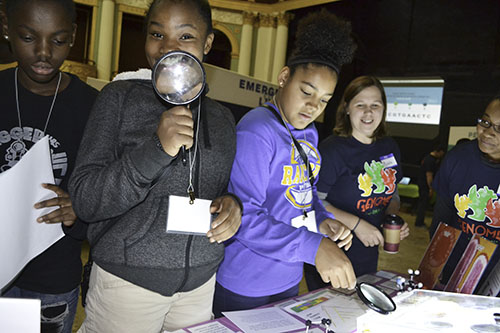
Participants take a look at bacteria at the Colorful Bacteria activity using magnifying glasses.
Genes vs. genomes: it seems that one needs a biology degree to tell the difference. One thing is for sure, however—neither of them are made of denim! Hundreds of people attending this year’s Genome Day, an event sponsored by the Carl R. Woese Institute for Genomic Biology (IGB), learned the difference through many fun and engaging activities supplied by over a hundred Illinois students, staff, and researchers throughout the afternoon of Saturday, November 11th. The purpose of the event? To educate the community, especially K–5th graders, on the topics of genes, genomes, and evolution. Participants could build 3D models of DNA, explore the Tree of Life to figure out how closely different species are related, and even extract strawberry DNA to make flavored candy necklaces.
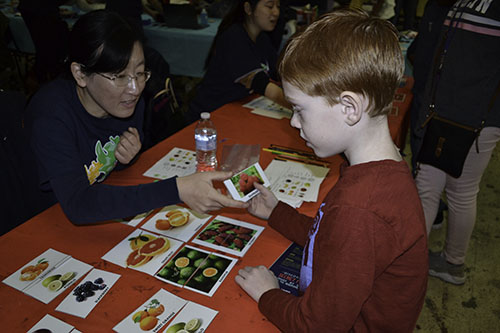
A local youngster at the Create Your Own Fruit activity booth at Genome Day 2017.
Each child was given a “passport” when they walked in the door of the Orpheum Children’s Science Museum in downtown Champaign for Genome Day. A message was encoded onto the sheet of paper that was only revealed when participants completed all the activities scattered at different tables around the room. Although the activities were mainly aimed towards K–5th graders, the free event was an amazing opportunity for people of all ages to learn more about biology in general…as well as a great opportunity to grab candy! A few of the afternoon’s activities are listed below:
- Design a Superhero
- Colorful Bacteria
- Punnett Eggs
- Create Your Own Fruit
- Delicious DNA
- Dancing Plants
- How Are Mammals Related?
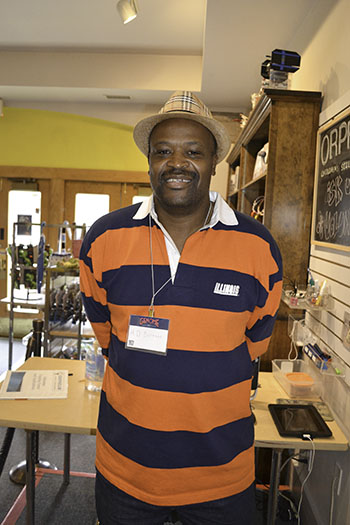
Herbert Duane Burnett, Masters student at EIU, attended Genome Day with his class.
Genome Day was a great opportunity to expose students not only to genomics, but to the University of Illinois. For instance, Herbert Duane Burnett, a Masters student at EIU, took his Leadership Development Academy (LDA) class from JW Eater Junior High School to Genome Day in order to broaden their horizons. Burnett wanted his students to be exposed to all the advantages that living next to a Big 10 university offers.
“I feel there is such a disconnect between the community and the college,” Burnett admitted. “And now that I'm back I just want to connect the dots. It takes a village, and it would be a tragedy for me to know that this awesome college is here, top in engineering and other areas, and the kids in its backyard don't know anything about it.”
When asked about the benefit of bringing his students to Genome Day, he replied, “Let them see successful college people, professors, [and] teachers. And just to broaden their mindset.” Burnett was hopeful that the exposure to STEM would get some of his students interested in the sciences and perhaps give them the inspiration to pursue a career in one of the various fields.
Connecting the dots was a popular reason for both attending and volunteering at Genome Day. For instance, working at the “Colorful Bacteria” table was Preston Hills-Rieck, a second year grad student working towards his Ph.D. in chemistry. He indicated, “I love being able to teach the broader community about science and how it is helpful. It's nice to be able to connect the dots for people that don't work with it every day.” At his table, participants could view artificially colored cultures of bacteria up close with a magnifying glass.
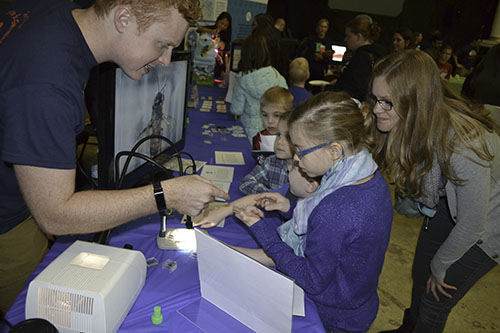
A group of youngsters show interest in different material displayed at the activity booth.
The volunteers at Genome Day were very enthusiastic to show kids all the different ways DNA affects their daily lives, from the plants they hate to eat, to the animals they love to play with. They hoped to take the many topics of science that Genome Day covers and reduce them to their simplest forms so that science lovers of all ages could grasp the concepts.
Many volunteers were also motivated to donate their time and energy to Genome Day in order to do a little recruiting to their field—to get the next generation of scientists, researchers, professors and engineers interested in the sciences as early as possible.
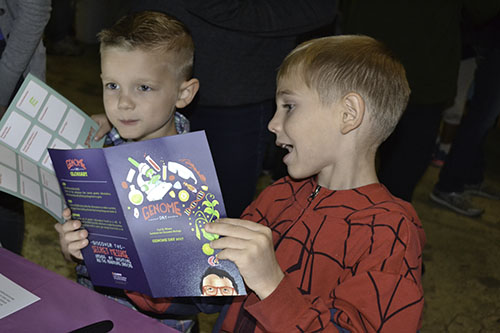
A local youngster takes a look at Genome Day activities that he could participate in.
This was the case with Kelley Guncalvis, a third year Microbiology Ph.D. student from Brazil who was working at the “Punnett Eggs” table. At the “Punnett Eggs” table, participants were encouraged to use Punnett squares to predict the traits of the offspring of the candy found in the egg they had picked up. (Candy appeared to be a pervasive theme throughout Genome Day.)
Staffing the “Punnett Eggs” table at Genome Day was Guncalvis’ first foray into outreach; she had had no previous experience volunteering and working with younger students. “I’m trying to interact with small kids and make them learn and get fascinated about science and show my passion about science,” she admitted.
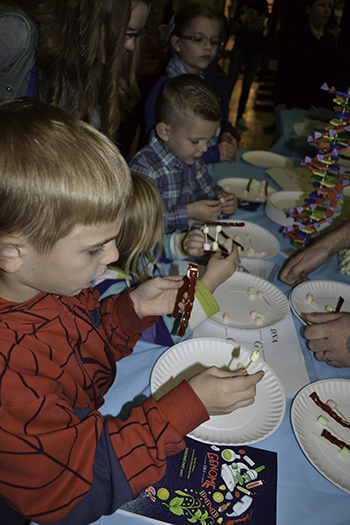
A group of youngsters make DNA structures out of candy at the Delicious DNA activity booth.
Guncalvis hopes to make a career of sharing her passion for science; when asked what her dream job would be, she responded, “If I could be a university professor with a lab, and teach at the same time, that’d be great.”
An undergraduate researcher working at the “How Are Mammals Related?” table, Aishwarya Raj, was very excited to volunteer at Genome Day because she had a lot of experience with outreach in her high school years.
“So I thought it'd be really interesting to teach kids about genomic research too,” Raj explains. “And when I was in high school, I used to teach a lot of kids and do programs at other high schools.”
As both Raj and Guncalvis show, volunteers can come from many different backgrounds to devote their time to educating the community. Raj has worked hard to get her position as an undergraduate researcher. She emailed many different professors whose work she was interested in and was able to secure a position as a researcher under her current professor, who then pointed her in the direction of Genome Day as an excellent opportunity to continue the outreach she had thrived on in high school.
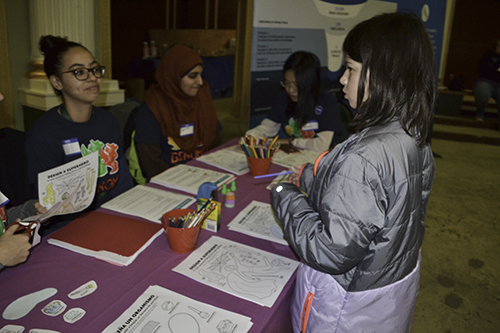
A participant at the Design a Superhero activity.
One of the more popular activities at Genome Day was the table Raj was working, “How Are Mammals Related?” She showed attendees a simplified version of the Phylogenic Tree, which shows how closely related to one another animals are in terms of their DNA. Humans are 99% similar to each other generally, with about a 1% difference creating all the diversity and uniqueness in our species. Using animal crackers, children and parents alike had fun figuring out their relationships with monkeys, giraffes, zebras, and elephants, oh my! A Thanksgiving meal with this truly extended family might end with the turkey being stolen!
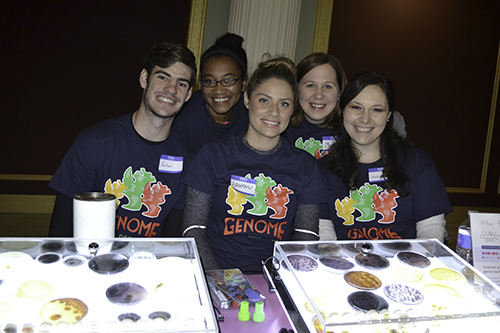
Students and volunteer staff at Genome Day 2017.
IGB’s Genome Day educated hundreds of people about genes, genomics, and DNA through many fun and engaging activities. Students, parents, and volunteers alike came to foster a love of science and biology in all participants, not just the K–5th graders the day was geared towards. The most important part of the learning? Having fun!
Story by: Nick O'Connell, I-STEM Undergradute Student Worker and a Sophomore in Mechanical Science and Engineering
Photographs by: Elizabeth Innes, Communications Specialist, I-STEM Education Initiative
For additional stories about Genome Day, see:
- Local K–5 Students Learn about DNA and Genomic Research at IGB's Genome Day
- IGB's Genome Day Exposes Visitors to Genomic Research
More: Biology, K-12 Outreach, Orpheum, 2017
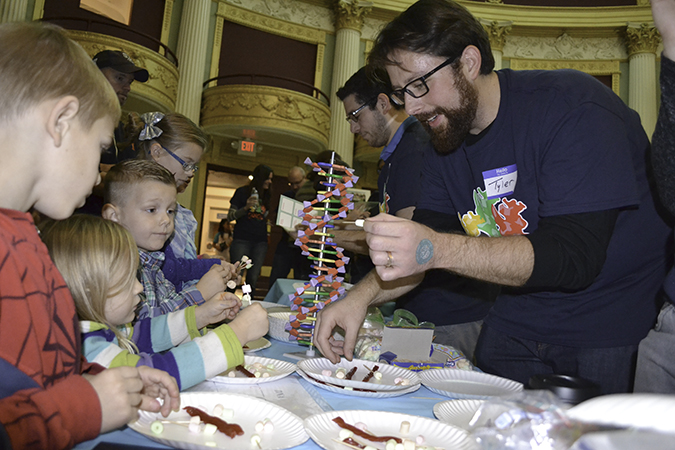
Staff and participants work together to connect candy to make DNA structures.













.jpg)
















